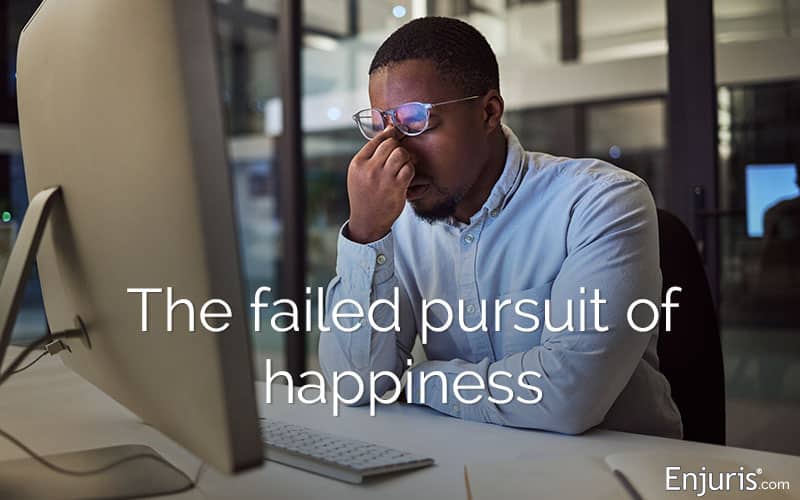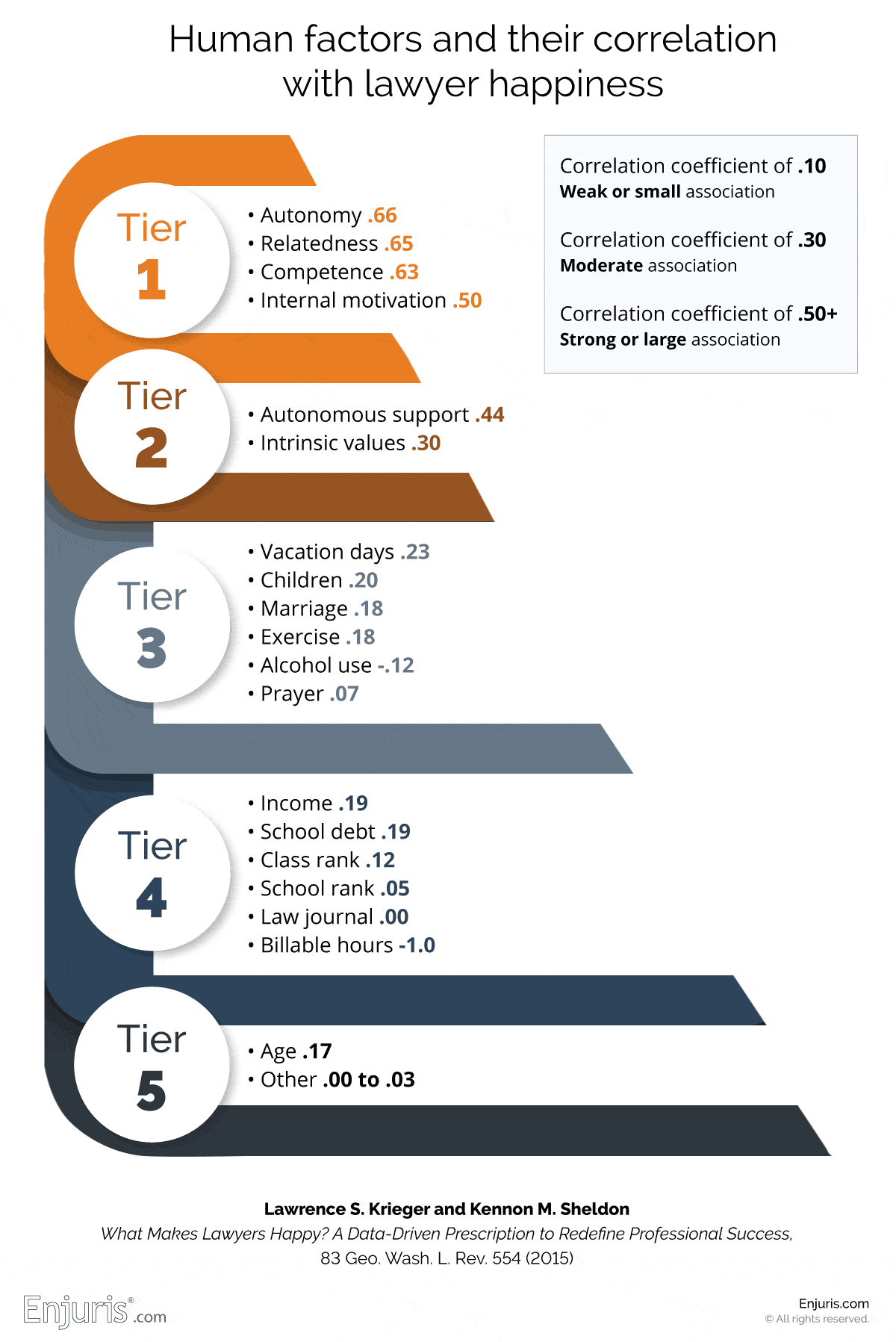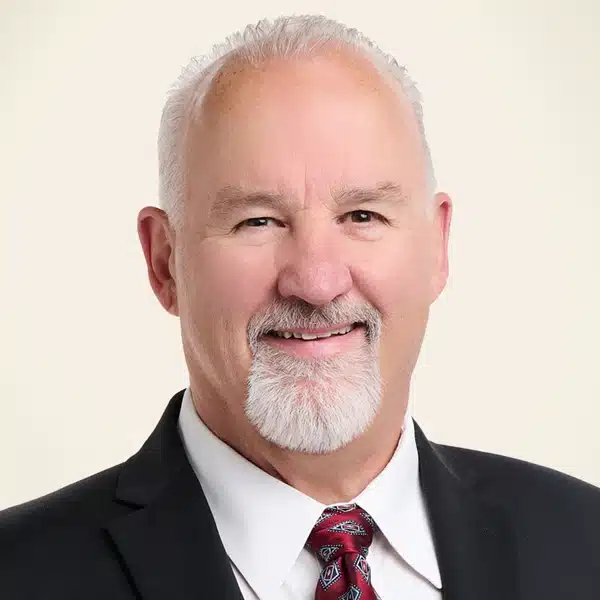What does the data tell us about mental health and well-being in the legal profession, and what are some practical tips to improve lawyer happiness?
During the summer of 2015, Eilene Zimmerman noticed something was wrong with her ex-husband, Peter. His behavior had become erratic. His voicemails and text messages were barely comprehensible soliloquies as though his once-brilliant mind had given way to a fireworks show.
Eilene worried the stress of his job had finally gotten to him. Peter was a high-powered attorney at Goodrich & Rosati, a prominent law firm based in Silicon Valley. He had been working more than 60 hours a week for more than 20 years.
When Eilene didn't hear from him for three days, she drove to his house. She used her key to unlock the door and began walking through the house, calling his name.
She saw the bloodied tissues first—scattered across his bed like wounded doves. When she entered the bedroom, she found him lying on the floor just outside the bathroom. Beside him lay a half-filled syringe, a lighter, and a spoon.
"Of all the heartbreaking details of his story, the one that continues to haunt me is this: The history on his cellphone shows the last call he ever made was for work. Peter, vomiting, unable to sit up, slipping in and out of consciousness, had managed, somehow, to dial into a conference call."
In the months that followed his death, Eilene sorted through Peter's text messages and bank statements, which gradually painted a picture of an uncommonly bright and successful attorney who had died a drug addict on his bedroom floor.
What makes a happy lawyer?
The United States Declaration of Independence lists the pursuit of happiness as one of three unalienable rights our government was created to protect.
As John Locke, from whom Thomas Jefferson borrowed the famous phrase, put it:
"[T]he highest perfection of intellectual nature lies in a careful and constant pursuit of true and solid happiness; so the care of ourselves, that we mistake not imaginary for real happiness, is the necessary foundation of our liberty."
But defining happiness and understanding what makes us happy has puzzled poets, philosophers, and laypersons for centuries.
"It seems to me that happiness is some blend of experience of pleasure and the experience of meaning and fulfillment in life," says Northwestern University professor of psychology Eli Finkel. "I think much more of the latter than the former."
In the 1920s, a research trend took hold in the United States. Researchers began looking at happiness and the methods available to gain happiness. Much of this research was targeted toward specific groups, including Black women and Jewish people. A vast literature emerged, coupled with a cultural commitment to happiness that inspired things like the happy birthday song (composed in 1926), music piped into department stores, happy meals, the iconic yellow smiley face, and eventually laugh tracks.
But it wasn't until decades later that researchers became interested in what makes lawyers—a stereotypically dour bunch—happy.
Factors that contribute to lawyer happiness
Florida State University Professor Larry Krieger became interested in studying happiness among lawyers while working as a government litigator. A few years later, after switching careers and becoming a law school professor, he had the opportunity to work with University of Missouri psychology professor, Dr. Ken Sheldon. The two set out to answer the seemingly straightforward question: Does the achievement of traditional career success lead lawyers to happiness, and if not, what does?
In 2015, Larry and Ken completed their landmark psychological study. The study gathered data from thousands of lawyers and judges across four states.
To the surprise of attorneys and non-attorneys alike, Larry and Ken's study found that the external factors typically associated with legal success (class rank, earnings, partnership, prestige) do not contribute to lawyer happiness. Conversely, internal factors that are less likely to impress at a cocktail party (autonomy, integrity, strong relationships, purpose) contribute dramatically to lawyer happiness.
Use this infographic on your site
We encourage people to use our infographics, with proper attribution. Just copy and paste the code below to use this infographic on your site. If you need help, let us know!
<a href="https://www.enjuris.com/students/lawyer-mental-health-and-well-being/" target="blank"><img src="https://www.enjuris.com/wp-content/uploads/2022/12/enjuris-human-factors-correlation-lawyer-happiness.gif" alt="Human Factors that Drive Lawyer Happiness infographic" title="" style="width: 100%; max-width: 750px; display: block; margin: 15px auto;" /></a>
As you can see from the two graphics above, internal factors have the strongest correlation with happiness. For context, a correlation coefficient of .10 is thought to represent a weak or small association, a correlation coefficient of .30 is considered a moderate correlation, and a correlation coefficient of .50 or larger is thought to represent a strong or large correlation.
The factor most correlated with happiness (autonomy) encompasses more than just the freedom to make one's own choices. As Larry Krieger explains in The Best Lawyer You Can Be: A Guide to Physical, Mental, Emotional, and Spiritual Wellness:
"[Autonomy] includes the need to have coherence between our self and our behaviors in day-to-day life. This means that choices and actions express our ‘true self' and ‘true values.' You can see that in normal parlance, it means your integrity—the extent to which you say what you mean, do not misstate or bend reality, and otherwise express what is inside you in your words and actions. This is the most important predictor of whether or not a lawyer is happy and satisfied most of the time."
Other surprising conclusions from Larry and Ken's landmark study include the following:
- Happiness does not vary significantly with the number of hours worked in a week. One possible explanation for this is that lawyers who enjoy their work may, in turn, work more hours.
- Happiness decreases as firm size increases. The happiest lawyers are solo attorneys. Unsurprisingly, solo attorneys report more autonomy, whereas lawyers at large firms report a stronger focus on external factors (such as earnings and billable hours).
- Lawyers who are married with children are happier than lawyers who are single and childless.
- There is an "almost meaningless" correlation between lawyer well-being and graduating from a higher-tier law school, despite a modest correlation with higher income.
The pillars of happiness
The results of Larry Krieger and Dr. Ken Sheldon's study came as a surprise to most attorneys, but the findings were old hat to psychologists.
Psychologists who study happiness have long believed that certain pillars contribute to a happy life. The terminology used to describe these pillars varies slightly between psychologists, but all of the pillars represent what Larry Krieger refers to as internal rather than external factors.
For example, positive psychologist Dr. Dan Daley, based in Provo, Utah, believes there are four pillars of happiness:
- Loving and engaged relationships
- A sense of purpose
- An attitude of optimism
- Connection to spirituality
Arthur C. Brooks, a Harvard professor and the author of From Strength to Strength: Finding Success, Happiness, and Deep Purpose in the Second Half of Life, identifies the following four pillars of what he calls "enduring happiness":
- Family relationships
- Real friendships
- Meaningful work
- A faith or life philosophy
"To promote lawyer happiness at our personal injury law firm, we encourage attorneys to collaborate with one another, capitalize on the ebbs and flows of work volume, and always emphasize that this is a family business, so family comes first."
What does the research tell us about happiness and well-being among lawyers?
If you're a lawyer or have been around lawyers, it probably won't come as a surprise to hear that lawyers are largely unhappy. However, they may not be quite as unhappy as previously thought.
Let's take a look at what the research tells us about lawyer happiness and well-being.
The 2015 American Bar Association-Hazelden Betty Ford Foundation study
The landmark study that alerted the world to the legal profession's mental health crisis was funded by the American Bar Association (ABA) and the Hazelden Betty Ford Foundation in 2015.
The study (hereinafter referred to as "the ABA study") looked at nearly 13,000 practicing attorneys and found that lawyers suffer much greater rates of depression, anxiety, and alcohol abuse than the general population.
Specifically, the ABA study found that:
- 36 percent of lawyers surveyed qualified as problem drinkers
- 28 percent of lawyers surveyed struggled with some level of depression
- 19 percent of lawyers surveyed struggled with anxiety
- 23 percent of lawyers surveyed struggled with stress
According to the ABA study, young lawyers in the first 10 years of practice and those working in private firms experienced the highest rates of problem drinking and depression, leading to obvious concerns about the future of the legal profession.
The ABA study also surveyed more than 3,300 law students and found that:
- 17 percent of law students surveyed experienced some level of depression
- 14 percent of law students surveyed experienced severe anxiety (23 percent experienced mild to moderate anxiety)
- 6 percent of law students surveyed reported suicidal thoughts
- 25 percent of law students surveyed were at risk for alcoholism
The 2021 National Health Interview Survey study
The National Health Interview Survey study (hereinafter, "the NHIS study") published in the Journal of Empirical Legal Studies in 2021 raised some concerns about the ABA study.
The NHIS study pointed out that the ABA study was based on weak empirical evidence—specifically, data collected from volunteer respondents as opposed to a random sample of lawyers.
"Because the volunteer survey respondents may not be representative of the general population of lawyers, it is inappropriate to rely on these data for estimating the prevalence of mental illness or excessive alcohol use for lawyers or comparing rates for lawyers with other populations who went un-surveyed. If lawyers struggling with mental illness are more likely to fill out the survey, for example, then the survey data will indicate a higher rate of mental illness than we find in a random survey of lawyers."
The NHIS study sought to remedy this perceived error by looking at a random sample of 1,000 lawyers using the "gold standard of public health data," the Center for Disease Control's National Health Interview Survey.
The NHIS study drew two notable conclusions based on the data:
- The percentage of lawyers with moderate to severe mental health issues is in line with that of doctors, veterinarians, dentists, and other similarly-educated workers.
- The percentage of lawyers with moderate to severe mental health issues is lower than that of people without a college degree.
Yale Law Professor Yair Listokin, who helped analyze the data collected in the 2021 study, cautioned that the results shouldn't be taken as evidence that attorneys don't struggle with well-being.
"It's not as though we should say, ‘OK, we don't have to worry about it," said Yair Listokin. "But in terms of, ‘Is there something uniquely wrong in the legal profession?' Maybe not."
Substance abuse in the legal profession
Perhaps the biggest surprise to come from the research into lawyer well-being is the prevalence of problematic alcohol use among legal practitioners.
The ABA study found that 20.6 percent of lawyers surveyed engaged in problematic drinking based on the Alcohol Use Disorder Identification Test (AUDIT).
The high stress associated with the occupation is one explanation for the high rate of problematic drinking among lawyers, but it's not a satisfactory explanation. An AUDIT-C subscale test, which focuses solely on the quantity and frequency of alcohol use, found that 36.4 percent of lawyers screened positive for problematic drinking, whereas only 15 percent of surgeons, an equally high-stress job, screened positive.
You might assume that lawyers begin drinking during law school, a notoriously stressful program, but 44 percent of lawyers in the ABA study stated that their problematic drinking habits began during their initial 15 years of practice.
Like the ABA study, the NHIS found that lawyers drink excessively at higher rates than the general population and at much higher rates than other highly-educated professionals.
The NHIS study further noted that problematic drinking among lawyers has grown considerably worse over the last decade, with today's rates more than 50 percent higher than the rates reported in the mid-2000s.
In addition to alcohol, lawyers struggle with other drugs. The ABA study found that within the previous year:
- 15.7 percent of lawyers surveyed had used sedatives
- 10.2 percent of lawyers surveyed had used marijuana
- 5.6 percent of lawyers surveyed had used opioid drugs
- 4.8 percent of lawyers surveyed had used stimulants
What's more, a large number of lawyers did not answer the questions about substance abuse, leading researchers to suspect that the numbers might be much higher.
Patrick Krill, one of the authors of the ABA study and a leading authority on addiction, mental health, and well-being in the legal profession, believes that a combination of factors—including professional demands, attorneys' personalities, and the profession turning a blind eye to problematic alcohol and drug use within its ranks—makes lawyers a risk for substance use-related disorders.
A 2022 study published in the Journal of Occupational and Environmental Medicine confirmed many of Patrick Krill's beliefs, concluding that burnout—characterized by overwhelming exhaustion, feelings of cynicism and detachment from the job, and a sense of ineffectiveness and lack of accomplishment—is a statistically significant predictor of drug abuse.
According to the study, law professionals whose burnout scores fell in the highest tier have 4.71 times higher odds of having a problem with drug abuse than those whose burnout scores fell in the second tier.
Suicide in the legal profession
A 1990 study conducted by researchers at Johns Hopkins University found that lawyers were 3.6 times more likely to suffer from depression than nonlawyers. The Dave Nee Foundation, a think tank that studies lawyer depression, followed up the Johns Hopkins' study years later and found that the legal profession ranks 5th in incidence of suicide.
Other studies have sounded the alarm on the prevalence of suicide in the legal profession:
- The 2016 ABA study found that 11.4 percent of lawyers had suicidal thoughts in the previous year.
- A 2021 law.com survey found that 19 percent of respondents contemplated suicide at some point in their profession.
- The NHIS study found that lawyers were five times more likely than the general population to die by suicide.
A case study
Gabriel MacConaill was a Los Angeles-based partner in the bankruptcy group of the esteemed law firm Sidley Austin.
Gabe was an extremely hard worker, but his workload became unbearable after several senior attorneys left his law firm over the course of a couple of years. Around the same time, Gabe was given even more responsibilities, including chairing the summer associate program, and was informed that no lateral hires would be made to assist with the increased workload.
After taking on a massive bankruptcy case, Gabe stopped sleeping and, perhaps even more worrisome to those who knew him, stopped smiling. He began working with his door closed and colleagues noticed his sense of humor was gone.
On the Sunday before filing the bankruptcy case, Gabe's wife called him at his office. Gabe told her that his body was failing him. His wife tried to convince him to go to the emergency room, but Gabe told her that a trip to the emergency room would be the end of his career.
The bankruptcy case was filed, but the pressure didn't relent. Gabe's wife finally convinced him to take a couple of days off from work. During those two days, she tried to convince him to quit his job, but he said he couldn't possibly quit in the middle of a case. Too many people depended on him.
On the morning of Sunday, October 14, 2018, Gabe received an email to go into the office. He grabbed the gun from his closet, drove to his office, and shot himself in the concrete parking structure of his high-rise office building. He was 42 years old.
"On the morning he killed himself, he said he got an email and had to go into work to put something together. I wanted to ask if I could go with him and just sit there, but instead, I simply offered to make him a sandwich for lunch. And without any hesitation, he said, ‘No baby, I'll be fine—I won't be long.'"
9-8-8
The 988 Suicide & Crisis Lifeline is a United States-based suicide prevention network of over 200+ crisis centers that provides 24/7 service via a toll-free hotline with the number 9-8-8. It is available to anyone in suicidal crisis or emotional distress.
Well-being among female lawyers
The body of research on lawyer well-being suggests that female attorneys are more likely than male attorneys to experience stress, anxiety, and depression and are also more likely to engage in problematic drinking.
A 2020 study conducted by the California Lawyers Association and the D.C. Bar found that the proportion of male legal professionals with problematic drinking behaviors is fairly consistent with men in the general population, but women in the legal profession had much higher rates of problematic drinking (39.5 percent) than women in the general population (19 percent).
What's more, the California Lawyers Association study found that:
- 67 percent of female attorneys reported moderate or severe stress compared with 49 percent of male attorneys
- 23 percent of female attorneys reported moderate or severe anxiety compared with 15 percent of male attorneys
- 20 percent of female attorneys reported moderate or severe depression compared with 15 percent of male attorneys
Studies also indicate that a wide gender gap exists with respect to attorney attrition, with some reports estimating attrition rates for women to be 150 percent higher than for men.
For many women, the usual challenges associated with practicing the law are compounded by being the primary caregiver and facing pervasive sexism that exists within the profession.
"We're still in some ways practicing law in a very similar fashion as we did when it was mostly men practicing," said Jeena Cho, an attorney who works with law firms on well-being and mindfulness. "A lot of courthouses to this day still don't have a mother's room where you can go pump, and that's just a very simple example of how the job is not designed to be accommodating to women at all."
Practical recommendations for positive change
The research on lawyer well-being, while not extensive—as of 2022, researchers at the University of Utah have identified only nine peer-reviewed publications examining lawyer well-being, nevertheless paints a clear picture of a deeply troubled profession.
Everyone has an interest in lawyers being healthy and happy. Unhappy lawyers not only present challenges for themselves and their family members, but they injure their clients by failing to provide adequate representation, as unhappiness and depression are intimately associated with passivity and poor productivity at work.
With all of this in mind, let's take a look at some practical ways legal employers, lawyers, and law schools can improve lawyer well-being and help change the narrative going forward.
Recommendations for legal employers
Legal employers have a moral and financial incentive to ensure the well-being of their employees. The moral incentive should be obvious, so let's focus on the financial incentive.
A number of studies have shown that the costs associated with promoting wellness at work are significantly outweighed by the financial benefits.
According to a study published in Health Affairs, for every dollar a company spends on employee wellness programs, medical costs fall by $3.27 and increased costs attributed to employee absenteeism fall by $2.73.
Here are some other notable findings from the study:
- Workplace health programs reduce presenteeism—the measurable extent to which health symptoms, conditions, and diseases adversely affect the work productivity of individuals who choose to remain at work.
- Because employee health behaviors frequently influence family members, employees who work for companies that value wellness are less likely to miss time caring for ill family members.
On top of the aforementioned benefits, legal employers who prioritize well-being will be more likely to retain top-notch employees and recruit new attorneys. This is particularly true in the midst of the current work-life reimagining, where employees are quitting their jobs in search of positions that allow for a better quality of life.
So how can legal employers prioritize lawyer well-being?
First and foremost, legal employers need to commit to doing better. In 2018, the Commission on Lawyer Assistance Programs (CoLAP) launched a campaign to promote best practices for law firms to take care of their attorneys.
CoLAP encourages legal employers to sign a pledge, which includes a seven-point checklist for employers to improve their messaging to lawyers about the employer's interest in well-being.
The CoLAP seven-point checklist for legal employers:
- Provide enhanced and robust education to attorneys and staff on topics related to well-being, mental health, and substance use disorders.
- Disrupt the status quo of drinking-based events:
- Challenge the expectation that all events include alcohol; seek creative alternatives.
- Ensure there are always appealing non-alcoholic alternatives when alcohol is served.
- Develop visible partnerships with outside resources committed to reducing substance use disorders and mental health distress in the profession: health care insurers, lawyer assistance programs, Employee Assistance Plans (EAPs), and experts in the field.
- Provide confidential access to addiction and mental health experts and resources, including free, in-house self-assessment tools.
- Develop proactive policies and protocols to support assessment and treatment of substance use and mental health problems, including a defined back-to-work policy following treatment.
- Actively and consistently demonstrate that help-seeking and self-care are core cultural values, by regularly supporting programs to improve physical, mental, and emotional well-being.
- Highlight the adoption of this well-being framework to attract and retain the best lawyers and staff.
As part of its campaign, CoLAP circulates an annual commitment form, which asks participants to describe any steps they took toward the objectives set out during the previous year and recommit to the pledge.
Similar to the CoLAP campaign, the Tristan Jepson Memorial Foundation identifies 13 factors for promoting psychological well-being in the legal profession and provides a survey and supporting documents to help employers assess and enhance these 13 factors.
Once a legal employer has committed to prioritizing well-being and has meaningfully communicated that priority to its employees, the legal employer can focus on improving lawyer autonomy, which we know from Larry Krieger and Dr. Ken Sheldon's study is the factor that most drives lawyer happiness.
There are a number of ways legal employers can improve lawyer autonomy. Perhaps the most significant way is to tackle the billable-hour problem.
The billable hour system, which forces lawyers to focus on hitting their hours rather than doing a good job, is the antithesis of autonomy. In recent years, more lawyers have spoken out about the many ills of the billable hour model.
Alternative fee models are becoming more popular across the globe. Fee models, such as value pricing, offer a number of benefits over the billable hour system, including a focus on profitability rather than revenue, a focus on effectiveness rather than efficiency, and the ability to provide clients with upfront pricing before any work is done.
Legal employers would also be wise to listen to their workers' wishes when it comes to when, where, and how they work.
"If the last two years have taught us anything," said Nick Lillios, CEO of Nowsta, a workforce management platform, "it's that flexibility is key in all aspects of life. More specifically, flexibility in the workforce is in high demand. We've transformed the way we've worked and it will only accelerate in the coming years. Not only are employers seeing the benefit of this way of work, but employees are more empowered to take a hold of their work-life balance."
A survey of nearly 2,000 ABA members found that 44 percent of lawyers that have practiced for 10 years or less would leave their job for another one that provides a greater opportunity to work remotely. Only 13 percent of lawyers practicing for 41 years or longer reported they would do so.
Flexibility, whether it takes the form of more remote hours or the autonomy to work some non-traditional hours, could go a long way in helping attract and retain female lawyers in particular.
Case study: The O'Melveny & Myers LLP CustOMMize program
O'Melveny & Myers LLP, a multinational law firm, made Working Mother's list of "Best Law Firms for Women" by offering a comprehensive workplace flexibility program known as "CustOMMize."
The program is intended to help support the retention of attorneys by "enabling them to tailor their schedules in a way that meets personal demands and client needs."
The program includes a job share program and a two-year sabbatical program, as well as flexible work schedules, telecommuting, and a "phase back" option for attorneys who want to return to work on a reduced workload.
Bradley J. Butwin, Chair of O'Melveny & Myers LLP, explains that: "By providing our associates and counsel with more options for managing their schedules, we believe we can increase retention of our high-quality attorneys and provide clients with continuity in the teams that serve them. It's a win-win."
Legal employers, perhaps because lawyers are trained to be risk averse, have a long-held reputation for being slow to innovate. But when it comes to improving lawyer well-being, law firms that refuse to implement practical and durable changes risk missing out on top-tier talent.
Legal employers can find more tips for improving the well-being of their employees in The Path to Lawyer Well-Being: Practical Recommendations for Positive Change, created by the National Task Force on Lawyer Well-Being.
Recommendations for lawyers
The research shows that happy lawyers have fewer symptoms of anxiety and depression, as well as better immune systems, cardiovascular health, and pulmonary functioning. What's more, happy lawyers have higher life and work satisfaction, and are less likely to engage in passive or poor work productivity.
Anne Brafford, an attorney who earned a Master's degree in Applied Positive Psychology, recommends that lawyers create a happiness plan as a way to bring more positivity into their lives. As part of that plan, Annie recommends trying to offset every negative experience with three to five positive experiences. The reason for this ratio is that, for evolutionary reasons, negative emotions are much stronger than positive ones, and therefore, you won't feel happy unless your positive emotions significantly outweigh your negative emotions.
To increase your positive experiences, consider some of the factors we know drive lawyer happiness:
- Loving and engaged relationships. A famous Harvard University study followed individuals from various economic and social backgrounds for more than 75 years (President John F. Kennedy was part of the original group). The study found that the number one predictor of happiness is having loving relationships with family and friends. The study also found that people with strong social support experience less cognitive deterioration as they age, and in fact, people's level of satisfaction with their relationships at age 50 was a better predictor of physical health than their cholesterol levels.
Investing in relationships can be a challenge for busy attorneys, but it's well worth the effort. Two things to keep in mind: be sure to share positive experiences with friends and family members (don't just vent) and aim for in-person interactions (rather than texting or using social media). - Meaningful work. We know that feeling a sense of purpose is one of the biggest contributors to happiness. Unfortunately, we're often stuck at jobs that don't give us meaning. For some attorneys, a job transition is worth considering. Reach out to the folks in your state bar association's career services department for help with a career switch. For other attorneys, taking on a "side hustle" or volunteering during the weekends might be the answer.
- A faith or life philosophy. It's not necessary to find a particular kind of faith to be happy. Rather, as Arthur Brooks explains: "The key is to find a structure through which you can ponder life's deeper questions and transcend a focus on your narrow self-interests to serve others."
- Activities that promote autonomy. We know that autonomy is the number one factor driving lawyer happiness. Attorneys would be wise to find ways to engage in activities that feel "authentic." To put it another way, take the time to do things that align with your interests and values.
There's no question that increasing your positive experiences takes work. We've created a series of worksheets to help you get the process started.
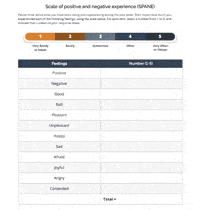
Research has shown that happy lawyers have fewer symptoms of anxiety and depression, better immune systems, cardiovascular health, and pulmonary functioning.
Download in PDF format
"As a tenacious and dedicated advocate, it can be difficult for me to take a break, or practice self-care. However, I have learned that this is essential if I am going to perform at my best. I'm no use to my clients if I am burnt out. Time management is key. Organizing my schedule so that I can take time to be with my family is vital for my mental health. It helps to keep me grounded, positive, and secure. I am reminded of my purpose, and of my identity outside of my work. This energizes me and enables me to return to the office with extra enthusiasm."
"When my daughter was born, I was working for a solo practitioner and had no real work-life balance. One of the only things I looked forward to at the end of the week was happy hour or going drinking with other lawyers and friends.
When I opened up my own law firm, I immediately found that I was much happier and was able to gain some control over my own life and move forward. Since that time, I've run my own firm for almost 11 years. I no longer drink alcohol and I work with a variety of coaches to assist me with my business, marketing, and health.
No longer being measured by my billable hours, I have been able to be involved in a variety of other groups and also mentor new attorneys. It's like night and day from where I used to work, and I am in such a better place that I want to make sure that other lawyers get that same message and are able to find a path that makes them happy as well."
Recommendations for law schools
Before starting law school, law students are actually healthier than the general population, both physically and mentally. Andy Benjamin, a psychologist and lawyer who teaches law and psychology at the University of Washington, points out that they drink less than other young people, use fewer substances, have less depression, and are less hostile.
In addition, law students typically start school with their sense of self and their values intact. Unfortunately, research shows that the structure of law school begins to change all of that. Once law school begins, students experience a marked increase in depression, negative mood and physical symptoms, with corresponding decreases in positive affect and life satisfaction.
"The psychological factors seen to erode during law school are the very factors most important for the well-being of lawyers," explains Larry Krieger. "The factors most emphasized in law schools—grades, honors and potential career income—have nil to modest bearing on lawyer well-being."
Dr. Debra Austin writes and speaks about how neuroscience and psychology research can improve the well-being and performance of law students. She lists seven things law schools can do to improve the well-being of their students:
- Identify organizational practices that may contribute to well-being problems and assess changes that can be made
- Educate faculty on well-being issues in the legal profession
- Provide well-being curriculum for students
- Provide student resources on mental health and substance use disorders
- Create a peer mentoring program
- Discourage alcohol-centered social events
- Survey student well-being
Law school administrators who wish to learn more about how to improve lawyer well-being should review the law school and law student resources collected by the ABA.
Additionally, we’ve developed a series of worksheets to help law students boost their happiness. These can be distributed by law schools to their students.
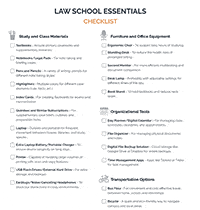
A checklist to ensure you’re fully prepared for every challenge that comes your way in law school.
Download in PDF format
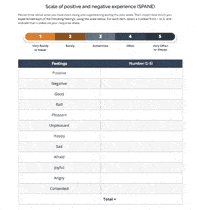
Research has shown that happy law students have fewer symptoms of anxiety and depression, better immune systems, cardiovascular health, and pulmonary functioning.
Download in PDF format
It may seem like the term happy lawyer is an oxymoron right up there with jumbo shrimp, civil war, and Shakespeare's "O brawling love! O loving hate!" But it's absolutely possible to be a happy lawyer in the twenty-first century; it just takes some hard work. Fortunately, working hard is something lawyers already know how to do.

